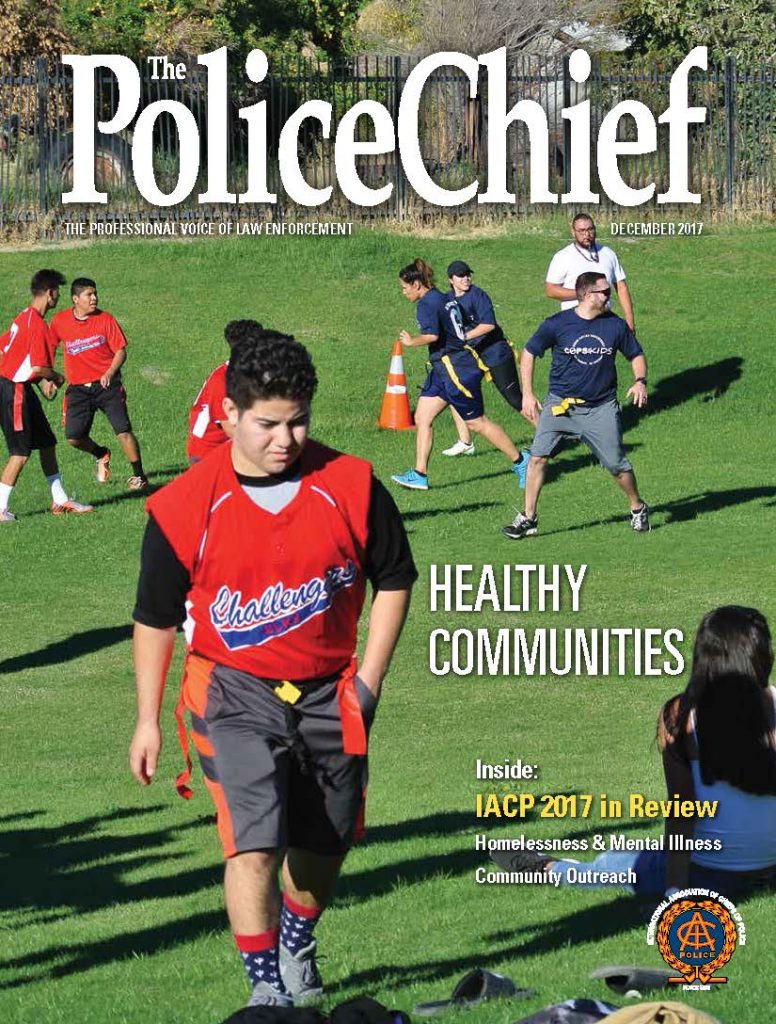
December 2017
Guest Editors: Jacqueline Ehrlich and Ana Gamez
The definition of a “healthy community” is somewhat nebulous, but it is generally accepted that healthy communities are low in crime and disorder and are home to community members who feel safe, who are engaged, and who work together to improve the quality of life for the whole community. Social health issues such as a dearth of mental health resources, homelessness, drug use, and inequality can all have damaging effects on the health of a community, and law enforcement has a responsibility to work with the community to find solutions.
Cover image courtesy of Indio Police Department, California.
Articles
-
Peeling Back: Recognizing the Public Are the Police
Law enforcement has come a long way since 1839 when Sir Robert Peel outlined his general instructions to be issued to every new police officer in the Metropolitan Police. Or has it? When Sir Peel defi... -
The Police Chief’s Guide to Carfentanyl: Making Sense of the Elephant Tranquilizer in the Room
The use of synthetic opioid analogues is emerging as a means to concentrate the effect, and hence profits, of heroin and other oft-abused drugs. The word “opium” is derived from the ancient Greek ... -
Mental Illness and Homelessness: How Suburban Cities Can Reduce the Impacts on Their Communities
One need only look to recent media reports to see examples of negative encounters between law enforcement and individuals with mental illness who are experiencing homelessness. For example, a man expe... -
Community Wellness through Engagement & Outreach: Strategies from Indio, California
The City of Indio is the largest and most populated city in the Coachella Valley desert region of southern California. The city’s estimated population is about 89,000; nearly 68 percent of residents... -
Atlanta Police Bring HOPE to People Who Are Homeless
It’s a warm August morning in Atlanta, Georgia. The stifling heat and humidity of late summer has yet to take hold. A vast sea of discarded junk food containers, clothes, shoes, water bottles, and o... -
Supporting Those With Mental Illness: Rethinking the Approach to a Vulnerable Population
The communities in which police officers work encompass a multitude of individuals with different ages, genders, incomes, races, ethnicities, religions, sexual orientations, abilities, health statuses... -
IACP 2017 Recap
Report of the 124th Annual IACP Conference and Exposition...
Columns
- President’s Message: Contributing to Healthy Communities through the One Mind Campaign
- Legislative Alert: CORRECTIONS Act
- Officer Safety Corner: The Critical Importance of Sleep for Police Officers
- Research in Brief: LEOKA Fatalities by Region and Jurisdiction Size and Type, 2007–2016
- Chief’s Counsel: The Tale of Videotape-Recording Police Officers
- From the Acting Commissioner: Innovating for Better Border Security
- Product Feature: RMS/CAD: Exploring Technology Brings the Future to the Present
- Technology Talk: Securing Law Enforcement Facilities with Audio
- Traffic Safety Initiatives: The Role of Law Enforcement in Reducing Speeding-Related Crashes Involving Passenger Vehicles
- IACP Working for You: Putting the “I” in IACP
- The Dispatch: December 2017
- Line of Duty Deaths: 10/13/2017–11/5/2017
- Product Update: December 2017
- Index to Advertisers: December 2017

